|
|  |
About The Cars
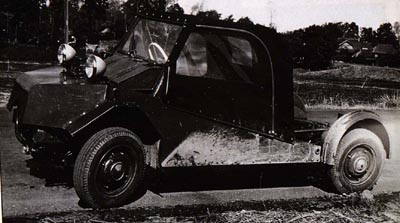 X170
X170
Honda can trace its automotive roots back to 1959 when they developed their first automobile test-mule (engine and body package) called the X 170. It utilized a 360cc, overhead cam, air-cooled, 60 degree, V4 engine fed by two side-draft carburetors mounted between the heads, and front wheel drive.
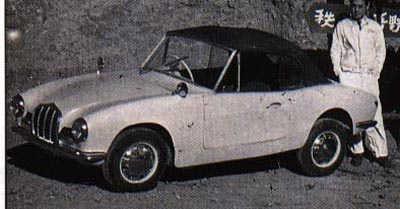 X190
X190
This gave way in 1960 to the X 190 test automobile, a 2 seat convertible sports car with a flat-four engine, rear wheel drive, a conventional live rear axle with leaf springs, and a fiberglass body.
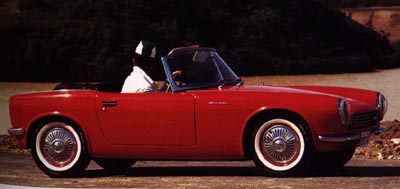 S360
S360
These were the predecessors to Honda’s first true production-ready, prototype auto, the Sports 360, which made its public debut at the 1962 Tokyo Motor Show. Powered by an all new, DOHC, water-cooled, in-line 4 cylinder engine with four carburetors, it produced 33 horsepower from 356cc at an unheard of 9,000 rpm. The car also featured a steel body, a five speed manual transmission, and for an automobile, a very unusual chain final drive utilizing aluminum swing arms which served double duty as chain cases, and also acted as trailing arms for independent rear suspension.
 T360
T360
It was shown alongside the T360, a small cab-over-engine pick up truck, and the S500, a larger-engined and larger-bodied version of the tiny sports car, both of which shared the S360’s basic engine design. The S360 never actually went into production because of conflicts with the contemporary Japanese Government’s size and displacement rules, and restrictive tax laws.
Fortunately for both us and Mr. Honda, his fiery character compelled him into fighting the government, and pushing forth with his plans to produce automobiles. The first Honda automotive product to actually go into production was the T360 truck in June of 1963. With a slightly detuned version of the S360 engine, it produced 30 horsepower at 8,500 rpm. Between June 1963 and August 1967, Honda produced 108,920 of these "sports trucks" in four different versions; a T360 with a conventional pick up truck bed (pictured); a T360F flat bed with wooden slats; a T360H with a flat pick up truck bed and sides that fold in addition to the tailgate; and a T360V "panel van" with an enclosed, hard cap over the bed.
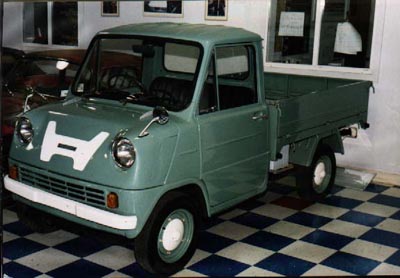 T500
T500
The T360's big brother, the T500, was produced from September1964 to November1967. It was available in two body styles; a conventional pick up bed, and the T500F, shown here, with the flatbed and sides that fold down in addition to the tailgate. Engine displacement was increased to 531cc, increasing the horsepower to 38 at 7,500 rpm. Total production over the four year span was 10,226.
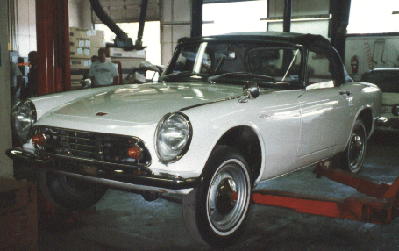 S500
S500
The S500 followed the T360 into production in October of 1963, earning itself the title of the first production Honda car. Initially introduced with a 492cc engine, the specifications read like those from a Formula 1 race car; double overhead camshafts, four carburetors, a needle roller bearing crankshaft, and a 9,500 rpm redline. The car produced 44 horsepower at 8,000 rpm from its later, production displacement of 531cc, weighed approximately 1,500 pounds, and could achieve a top speed of 80 miles per hour.
A four speed transmission (with synchromesh on the top three gears) was utilized. Final drive was by oil bath chains to the rear wheels. Four wheel independent suspension was achieved using torsion bars in the front, and diagonally attaching coil-over-shock strut units to the rear of each chain case.
Brand new, it sold for the equivalent of $1,275. A fiberglass hardtop was offered as an optional accessory. There were 1,363 S500s produced between October 1963 and September 1964 (136 in 1963, and 1,227 in 1964), when it was supplanted by the larger-engined S600.
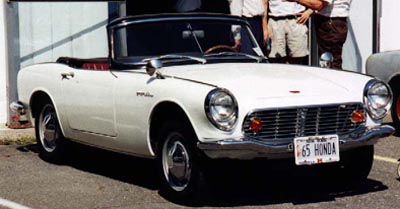 S600
S600
The S600, launched in March of 1964, was the first Honda car to be offered in two versions; a convertible almost identical to its S500 sibling, and a fastback coupe, introduced in March of 1965. Styling would remain pretty much the same, with the most noteworthy changes coming to the front grille, bumper, and headlights.
For this model, the engine capacity was increased to 606 cc. The engine produced 57 hp at 8500 rpm and had a top speed of 90 mph. With the convertible weighing in at 1576 pounds, the extra sheet metal of the coupe only added 33 pounds to the overall weight.
The S600 was the first "mass marketed" Honda car. First offered with right hand steering only, it soon became available in left hand steering so as to be appealing to the export market. (There were a few pre-production S500s manufactured with left hand steering, two or three even being shown in some early sales brochures, but all production S500s were right hand drive.)
Both the S600 roadster and coupe were available in standard trim and a special, upgraded package called the SM600 which included, among other items, special paint colors, exclusive badging, a standard radio and speaker, a special antenna in the passenger side sun visor, standard reversing lights, a standard cigarette lighter, a standard heater, better cushioned seats, and a detachable seat track for quick removal of the passenger seat.
Production of the S600 was much greater than that of the S500. In fact, of the three production engine sizes for the sports cars, the S600 had the highest figures.
Honda built 3,912 roadsters in 1964, with production climbing to 7,261 convertibles and 1,519 coupes in 1965. Production dropped off in 1966 (as they were shifting to the S800) with only 111 roadsters and 281 coupes, giving tallies of 11,284 convertibles and 1,800 coupes for the 3 year span.
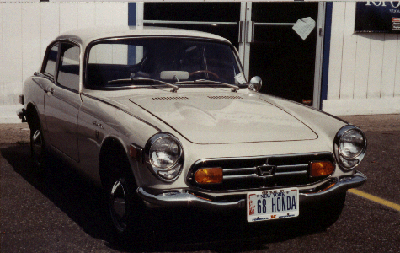 S800
S800
The S800 was introduced to the world at the 1965 Tokyo Motor Show, and offered for sale in 1966. For this displacement increase, there would be some significant styling changes to both the front and rear of the car, while again being available in either roadster or coupe form. The early S800 would also be sold in standard and "SM" trim levels.
The displacement was increased to 791cc which resulted in 70 hp at 8000 rpm. The S800 reached 100 mph and still boasted 35 mpg. The first 752 convertibles and 242 coupes continued the chain rear drive and independent rear suspension of its predecessors. For the next 604 roadsters and 69 coupes, Honda replaced the rear chain / suspension configuration with a more conventional live rear axle located by four radius rods and a panhard rod, while retaining four wheel drum brakes. Thereafter, front disk brakes replaced the four-wheel drum setup, while continuing the live rear axle for the remainder of the production run.
The next significant change came in 1968 with the introduction of the S800M version. Aimed at the American market, Honda made changes to include flush door handles, side marker lights, dual circuit brakes, varied taillight configurations to suit different markets, safety glass, leaner carburetion, and more. (They went so far as to show a "USA Model" in the parts catalogues and owner's manuals, but no S800s, or for that matter any S series cars, were ever officially imported into the US for retail distribution.)
All the changes were in vain, however, as the high revving engine produced too many hydrocarbons. New safety and emissions regulations were being introduced and the S800 did not measure up. Without the support of the American market, Honda ceased production of the S800 in May 1970.
A total of 11,536 S800s were produced between 1966 and 1970.
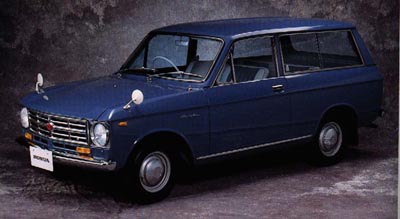 L700
L700
The L700 and the P700, introduced in October and November 1965 respectively, were commercial vehicles that, like the T series, were based on the S series driveline. Their engines were basically enlarged 687cc S600 engines that were fed by two side-draft carburetors and produced 52 horsepower. Both models utilized a four speed, manual transmission with a steering column mounted shifter.
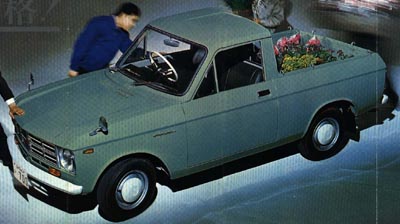 P700
P700
The L700 station wagon (Honda referred to it as a "light van") was available in two trim levels; the basic LA700, and the better appointed LM700. The P700 light truck was slightly more conventional in body style than the cab-over-engine T series, with both models using coil springs and shocks for their front suspension while keeping with leaf springs and a solid axle in the rear.
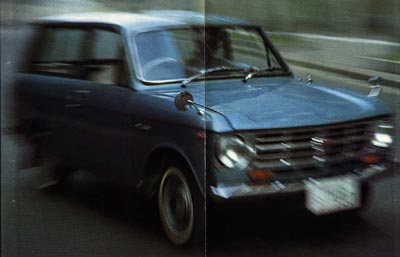
L800
The L800 and P800, both first shown at the 12th Tokyo Motor Show in 1965, were virtually carbon copies of their 700 siblings. Available for sale starting in 1966, their main difference was their powerplant. They borrowed a detuned S800 engine with a single side-draft carburetor that produced 58 horsepower. Like the L700, the L800 was available in the same two trim levels.
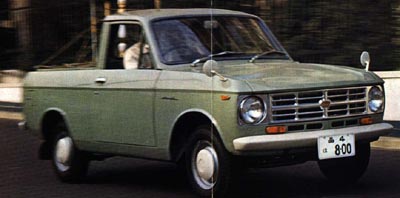 P800
P800
Production figures borrowed from Toshikazu Kominami's AS FILE lump both displacement's tallies together for the entire production run, which ended for all 4 models in 1967. 1965 production started at 1,814 for the "L"s and just 80 for the "P"s. 1966 saw production peak at 13,192 Ls and 1,446 Ps, with figures for 1967 winding down to 5,038 Ls and 876 Ps. It can be assumed that since only the 700s were being produced in 1965, that the totals for 1965 apply only to them.
There were 25,983 S series produced during an eight year run (1963-1970) along with 119,146 T series over a five year span (1963-1967). Yet, there were only 20,044 L series and 2,402 P series produced over their three year run (1965-1967).
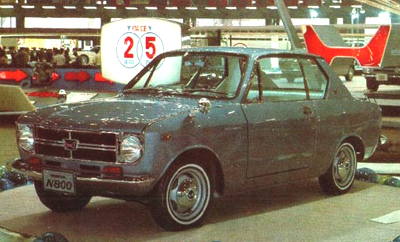 N800
N800
The N800 (not to be confused with the N600, with which it shared absolutely nothing in common) was only a prototype. It shared the L800 / P800 driveline, was also shown along with its S, L, and P sisters and brothers at the 1965 Tokyo Motor Show, but was never produced.

|



 X170
X170 X190
X190 S360
S360 T360
T360 T500
T500 S500
S500 S600
S600

 L700
L700  P700
P700 
 P800
P800  N800
N800